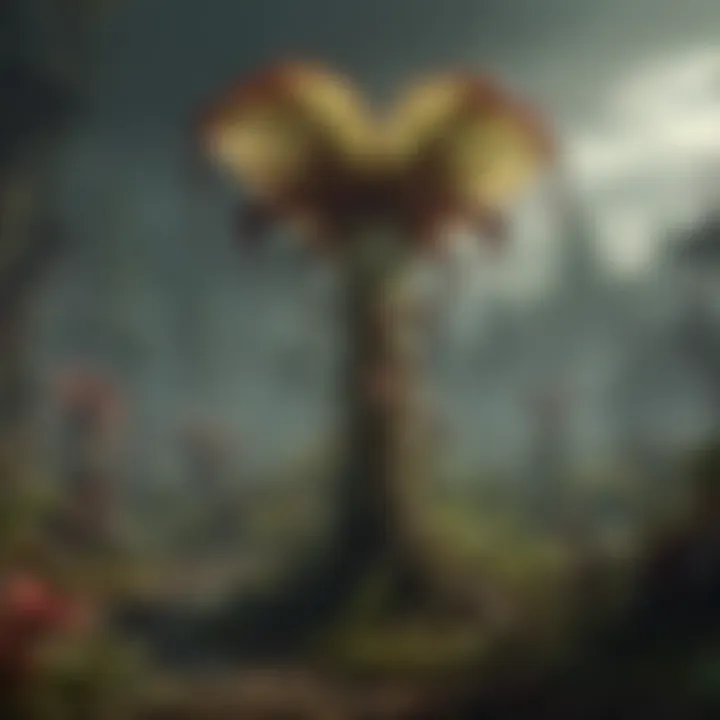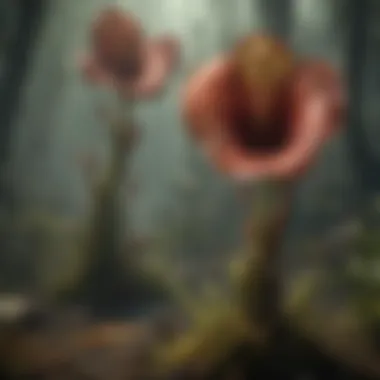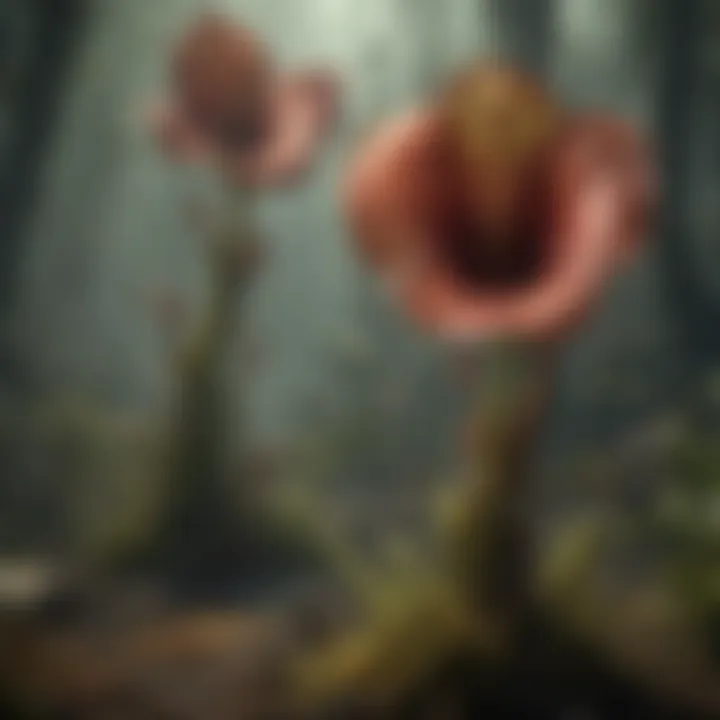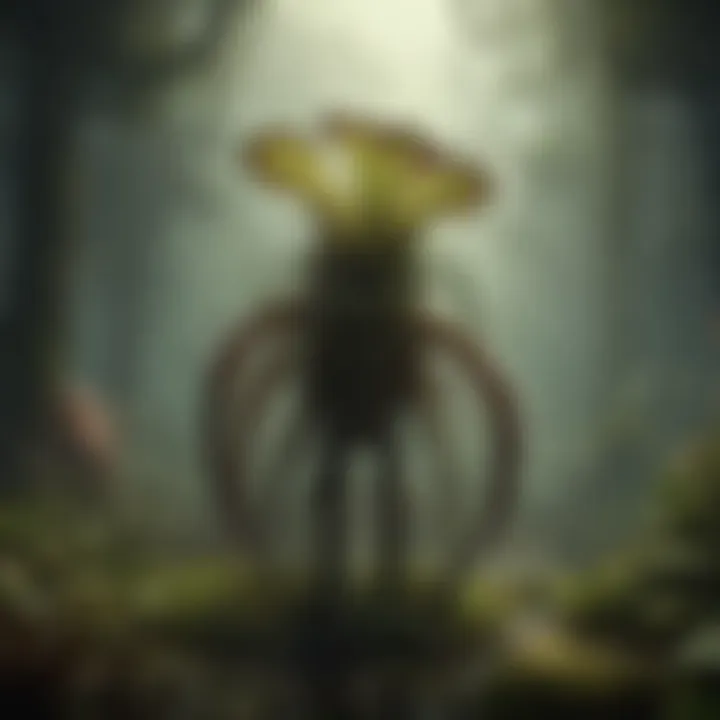Exploring the Intriguing World of Giant Carnivorous Plants


Intro
Giant carnivorous plants have long captivated the imagination of scientists, nature lovers, and casual backyard observers alike. These botanical wonders, often found in nutrient-poor environments, employ unique adaptations to capture and digest prey, showcasing an extraordinary relationship between flora and fauna. By examining the intricacies of their biology and ecology, we can better understand how these stunning organisms have developed their predatory behavior and contribute to their ecosystems. This exploration goes beyond mere botanical interest; it taps into essential themes of survival, adaptation, and the complex interplay of life forms on our planet.
Whether it’s the infamous Venus flytrap snapping shut on unsuspecting insects or the towering pitcher plants luring prey into their deep, slippery chambers, these plants are not just curiosities. They are models of ecological ingenuity, illustrating nature’s oft-overlooked versatility and complexity. Their existence also challenges conventional perceptions of plants as passive entities, reminding us that the world of vegetation is far more dynamic than we might presume.
As we journey through this article, we’ll dissect the various adaptations of giant carnivorous plants, examine the ecosystems they inhabit, and delve into the cultural significance that these organisms hold. Let’s embark on this fascinating exploration of nature’s predators.
Understanding Carnivorous Plants
Understanding carnivorous plants offers a fascinating glimpse into the diverse strategies of survival in the plant kingdom. These unique organisms go beyond the typical role that plants play in nature, not just capturing sunlight for energy but actively hunting for nutrients. By studying these plants, one gains insights into their adaptations, ecological importance, and even their role in cultural narratives. The topic provokes curiosity and provides a backdrop to understand complex ecosystems where these flora live.
Definition and Characteristics
Carnivorous plants are defined by their ability to obtain nutrients by trapping and digesting prey, primarily insects. This trait is particularly useful in nutrient-poor environments, such as bogs or sandy soils where traditional means of nutrient uptake fall short. The physical traits of carnivorous plants can vary widely, from the well-known Venus flytrap with its jaw-like leaves to the pitcher plant that lures prey into a digestive pool.
Their adaptations are not just fascinating from a biological perspective but are also crucial for their survival in specific habitats. The combination of attraction strategies—color, scent, and even secretions—work collaboratively to draw in unsuspecting insects. The complexity of these characteristics presents a rich area for exploration in understanding how plants can thrive in challenging environments.
Types of Carnivorous Plants
Carnivorous plants can be broadly categorized based on their trapping mechanisms, feeding methods, and growth patterns. This categorization not only helps in identifying species but also frames conversations about their evolutionary strategies.
Trap mechanisms
Trap mechanisms are pivotal to the survival of these plants. They vary significantly, illustrating a spectrum of innovation in how plants adapt to get nutrients. The most popular kinds include:
- Snap traps: like the Venus flytrap, which utilizes rapid leaf closure to catch prey.
- Pitfall traps: such as pitcher plants, where insects drown in a pool of digestive fluid.
- Flypaper traps: where sticky mucilage captures unsuspecting insects.
Each mechanism has its unique benefits and drawbacks. For instance, the snap trap is quick and efficient but requires specific conditions for triggering closure. In contrast, the pitfall trap does not need immediate activation but often lures fewer insects overall due to its passive nature.
Diversity in feeding methods
The diversity in feeding methods among carnivorous plants adds another layer to their intrigue. They adapt based on nutrient requirements, resulting in different techniques to capture and digest prey. Some common strategies include:
- Insectivory: primarily targeting insects for nutrients.
- Nectarivory: producing nectar to attract pollinators while also trapping insects that come to feast on the sweet substance.
This diversity not only illustrates adaptability but encourages a broad range of dietary practices. However, it also means that plants with narrow feeding habits can be more susceptible to changes in their environment.
Growth patterns
Growth patterns in carnivorous plants can be as varied as their feeding strategies. This subsection deals with how these plants develop in relation to their environments. Many species exhibit:
- Rhizomatic growth: allowing plants to spread horizontally across the nutrient-poor soil, maximizing their hunting ground.
- Seasonal growth cycles: where some species can be dormant during harsh conditions while others may thrive, showcasing resilience and adaptability.
These growth patterns not only reflect their strategies to obtain food but inform their entire life cycles. For example, a plant that stops growing during dry spells might conserve energy, only to spring back when conditions improve.
The exploration of carnivorous plants sheds light on the myriad survival strategies that exist in nature. These adaptations showcase the incredible ways that life can thrive even in the most challenging of environments.
Giant Carnivorous Plants: An Overview
Giant carnivorous plants present an intriguing sector of the botanical world, drawing attention not only for their size but also for their unique adaptations that enable them to thrive in nutrient-poor conditions. This section provides an essential understanding of the fundamental characteristics that define these plants, laying the groundwork for a deeper exploration of their biology and ecological roles.
Species Identification
Notable examples
Indeed, numerous species showcase the captivating traits that enable giant carnivorous plants to stand out. One prime example is the Nepenthes rajah, which can reach impressive heights nearing three feet. This species is notable for its large, pitcher-shaped leaves that serve as traps, drawing in insects with their sweet nectar. The sheer size and peculiar formation of its traps make it a popular subject for botanical enthusiasts and researchers alike. Additionally, these giant traps also allow for a more efficient digestion process, providing plants with the nutrients they need to survive in their challenging environments.
Identification features
When it comes to identifying these giants, the morphological traits are key. Carnivorous plants like the Sarracenia giant exhibit a range of leaf shapes, colors, and textures that can be quite variable, depending on the species and environmental factors. The combination of vibrant hues and intricate patterns not only has aesthetic value but also practical purposes, such as attracting prey. Understanding these features helps distinguish between different species, enriching the narrative of these fascinating plants.
Geographical distribution
The geographical distribution of giant carnivorous plants tells a compelling tale of adaptability. While native to regions with particular climates—often found in Southeast Asia, North America, and parts of Australia—these plants colonize wetlands, bogs, and other nutrient-deficient environments. Their distribution patterns also provide insight into the ecological niches they fill, relying on water-logged habitats that many other plants find inhospitable. Their particular habitats also create a unique ecological balance, profoundly influencing local ecosystems.
Size and Growth Conditions
Preferred habitats
Preferred habitats for giant carnivorous plants are closely linked to their survival needs. Generally, they thrive in wet, acidic soils that drain poorly, which is substantial in offering them a foothold in nutrient-poor regions. Furthermore, sunlight plays a crucial role, as these plants benefit from bright, indirect light. However, it's essential to maintain some level of moisture in these habitats to ensure plant health. Understanding these aspects of their habitats enhances our appreciation for their ecological significance.
Environmental requirements


The environmental requirements for growth reveal the delicate balance these plants maintain with their surroundings. A precise combination of pH levels in the soil and moisture content is crucial for proper development. Additionally, temperature fluctuations have a role; some species prefer warmer climates, while others can tolerate cooler temperatures. Such understanding assists in informing conservation strategies and gardening practices for enthusiasts concerned with cultivating these extraordinary plants.
Growth stages
The growth stages of giant carnivorous plants provide insight into their life cycle and resilience. From seed germination through multiple stages of development, these plants exhibit varying characteristics that can be remarkable. For example, young plants often display compact forms that gradually stretch and develop larger traps as they mature. It’s an evolutionary advantage, ensuring better survival against both predators and competition for resources. Observations of these stages can benefit horticultural practices and ecological understanding of these species.
"Understanding the intricate relationship between giant carnivorous plants and their habitats can lend enlightening perspectives to their joint survivability."
In summation, this overview of giant carnivorous plants opens a window to their unique identity within the plant kingdom. By highlighting species identification, environmental factors, and growth stages, we can appreciate their complexity and indispensable contributions to biodiversity. This section sets up a pathway to delve deeper into the intriguing biology of these magnificent organisms.
Biology of Giant Carnivorous Plants
Understanding the biology of giant carnivorous plants is a critical piece to unraveling their nature and ecological roles. These plants are not simply exotic specimens; they have evolved remarkable adaptations to thrive in nutrient-poor environments by capturing and digesting animals. This fascinating functionality allows them not only to survive but also to dominate specific ecological niches. The various structures and processes at play in their biology showcase their ingenuity and complexity.
Anatomy and Structure
Root systems
The root systems in giant carnivorous plants serve multiple purposes crucial to their survival. Unlike traditional plants that heavily rely on the soil for nutrients, these roots are often shallow, reflecting their adaptation to conditions where nutrients are limited. A key characteristic of these roots is their ability to stabilize the plant in loose substrate, commonly found in wetlands. The roots also help absorb water and some nutrients, although they aren't the primary means of nutrient acquisition.
One unique feature of their root systems is their tendency to form symbiotic relationships with fungi, which can help break down organic matter, thus allowing the plant to access nutrients. This mutualistic feature can be significant in its productivity but also has disadvantages; should the mycorrhizal fungi be compromised, these plants might struggle.
Leaf adaptations
The leaf adaptations of these giant plants are perhaps their most striking aspect. They have evolved various trapping mechanisms such as pitcher shapes, sundew sticky glands, or snap traps. The ability to lure and capture prey showcases how their leaves have adapted for a carnivorous lifestyle. A notable feature is the sticky secretion found in sundews, which not only traps insects but also digests them.
This adaptability makes them extraordinary producers in their ecosystems. However, not all leaf adaptations are equally efficient; some traps may rely on specific prey types, which limits their dietary options.
Digestive mechanisms
Digestive mechanisms among giant carnivorous plants are equally fascinating. After capturing prey, these plants have developed a suite of enzymes to break down proteins and digest the captured organisms. A critical feature here is that they often rely on bacteria to aid in this process, making it a cooperative effort. This allows the plant to absorb nutrients effectively, which can lead to rapid growth in optimal conditions. The intricacies of these digestive systems underline how such plants have adapted to their environments.
However, there are vulnerabilities as well. If the enzymes or the beneficial bacteria falter, it could hamper nutrient processing, which ultimately affects the plant's health and growth potential.
Photosynthesis and Nutrient Acquisition
Exploring photosynthesis and nutrient acquisition brings us closer to understanding how giant carnivorous plants balance their unique feeding habits alongside standard photosynthetic needs.
Role of sunlight
The role of sunlight cannot be overstated in the survival of these plants. Sunlight provides the energy to fuel photosynthesis, a critical process for producing the sugars necessary for growth. A key characteristic of these plants is their ability to thrive even in partially shaded environments, which is common in their native habitats.
Moreover, the ability to maximize light capture through specialized leaf structures enhances their growth potential. Nevertheless, inadequate sunlight can stunt growth and affect their overall health, particularly in species that depend on intricate trapping mechanisms.
Nutrient absorption
Nutrient absorption in giant carnivorous plants is a dual approach, where they leverage both photosynthesis and carnivory. A notable characteristic is their ability to absorb ligands and minerals from decaying prey through their leaves, allowing a rapid influx of essential nutrients. This adaptability can significantly enhance their performance in nutrient-poor habitats.
However, this method means they remain reliant on successful prey capture, and if their trapping fails, the nutrient intake could plummet, leading to diminished health and growth.
Energy conversion strategies
Energy conversion strategies of these plants illustrate a fascinating interplay between carnivorous and autotrophic processes. The efficiency with which these plants convert both sunlight and nutrients from prey into energy can greatly influence their growth rates. A unique aspect here includes the ability of some species to down-regulate their energy expenditure during unfavorable conditions, which acts as a survival tactic.
While these strategies enhance their adaptability, they can also lead to a delicate balance; fluctuations in their environment can disrupt this connection, impacting their survival prospects.
"The transformation of sunlight and nutrients into energy reveals the complex interplay of biology and ecology in giant carnivorous plants."
Ecological Significance
The study of giant carnivorous plants unveils insights into their critical roles within ecosystems. These unique organisms not only fascinate with their predatory habits but also contribute significantly to the environmental balance. Understanding their ecological significance is crucial, as it encompasses both interconnections within ecosystems and the ongoing efforts to protect their habitats.
Role in Ecosystems
Food web dynamics
Giant carnivorous plants are pivotal in shaping food web dynamics. Their presence introduces an intriguing layer to ecosystems, where they function as both predators and prey. These plants primarily target insects, helping to regulate their populations. This control is essential, as large swarms of certain insects can lead to various ecological imbalances.
One essential characteristic of these plants is their ability to thrive in nutrient-poor soil, leading them to evolve their carnivorous nature. This adaptability makes them a beneficial choice for the overall health of their environment. Unlike traditional plants that rely heavily on soil nutrients, these giants derive essential nutrients from their prey. In doing so, they promote biodiversity by creating a unique niche that supports various insect species, which in turn can serve as food for other animals.
Impact on insect populations
When we consider the impact giant carnivorous plants have on insect populations, it's quite evident they create a balancing force. By capturing and digesting insects, these plants help maintain population levels, preventing any one species from overwhelming the ecosystem. Their unique structure, often equipped with enticing lures and deadly traps, ensures that they are effective predators.
This characteristic proves to be a popular choice for this discussion because it emphasizes the plants' function not just as killers but as vital components of the environment. Their selective predation limits competition and can offer stability, allowing for a more diverse range of species to thrive within their habitat.


Inter-species interactions
Inter-species interactions are yet another important aspect of the significance of giant carnivorous plants. These plants influence various relationships in the ecosystem, forming symbiotic associations with other organisms. For instance, some carnivorous plants release specific scents that attract pollinators, demonstrating a fascinating exchange of benefits.
This characteristic highlights an essential feature of inter-species interactions: the interplay between survival strategies and ecological roles. This not only helps the plants with pollination but also supports the wider ecosystem through complex relationships, which enhances overall resilience. A downside is that some of these interactions can lead to unintended consequences, where certain species become overly reliant on the plants for survival.
Conservation Status
Threats to habitats
The habitats of these spectacular plants face various threats primarily stemming from human activities, like habitat destruction and climate change. Urbanization and agriculture encroach on their natural habitats, fragmenting populations and hindering their growth. This threat is critical to discuss as it lays bare the vulnerability of these unique species.
What stands out about these threats is their speed and impact on biodiversity. As habitats diminish, the potential for genetic diversity declines as well, further complicating conservation efforts. Therefore, understanding the specific threats these habitats face is vital for implementing effective conservation strategies.
Conservation efforts
Ongoing conservation efforts have emerged as a response to the escalating threats. Organizations and researchers are taking significant strides to protect these plants and their habitats. Some notable initiatives include habitat restoration projects, seed banking, and environmental education programs aimed at raising awareness about the importance of these plants.
Focusing on these conservation efforts is crucial, as they embody a proactive approach to mitigating risks and ensuring these remarkable plants persist for future generations. Unique aspects of these initiatives include collaborative approaches that involve local communities, ensuring broader support for conservation.
Importance of biodiversity
The importance of biodiversity becomes evident when examining the role of giant carnivorous plants in maintaining ecological health. These plants contribute to the overall diversity of species found in their habitats, revealing a rich tapestry of life forms that depend on one another for survival. By supporting various insect populations and acting as a food source for other animals, they enhance ecosystem complexity.
Emphasizing biodiversity sheds light on how even seemingly small plant species can have far-reaching effects on their environment. The more diverse an ecosystem, the more resilient it tends to be against disturbances and climate change, thus highlighting the necessity for conservation of these extraordinary plants.
Cultural and Historical Context
The cultural and historical context surrounding giant carnivorous plants offers a fascinating lens through which we can appreciate their significance beyond mere biology. These plants have not only captured the imaginations of scientists and naturalists but have also permeated folklore, art, and literature. Their unique characteristics make them symbolic of nature's unpredictability and ingenuity, illustrating both a wonder and a cautionary tale about the natural world.
Mythology and Folklore
Cultural representations
The cultural representations of giant carnivorous plants often portray them as mysterious and formidable entities. In various cultures, these plants are linked to themes of deception and the allure of the unknown. For example, in some Asian mythologies, they are seen as guardians of the forest, seducing the unsuspecting into their embrace. This perspective lends a rich narrative to their existence, enhancing their allure. Such representations are beneficial for exploring how humans relate to fearsome aspects of nature. One unique feature is that these stories often warn of meddling with forces we don’t fully understand, which can resonate deeply with audiences today. However, it can also lead to negative portrayals that overshadow their ecological roles.
Literary references
In literature, literary references to carnivorous plants often serve as metaphors for various human experiences. Notable works, like those of H.G. Wells or Kiera Cass, illustrate these plants as agents of change or morality, threading them into narratives that explore themes of survival, greed, or hubris. This key characteristic makes literary references a compelling element for discussing human nature alongside botanical curiosities. These references can be advantageous in fostering deeper conversations around ethical considerations regarding nature. However, twisted interpretations may lead some readers to view these plants solely as antagonistic figures in stories.
Symbolism in art
The symbolism in art regarding giant carnivorous plants often amplifies their otherworldly quality, representing nature's capacity for both beauty and danger. Many artists choose to depict these organisms in their grotesque form, capturing the duality of attraction and repulsion they evoke. This key characteristic allows artists to illustrate complex emotions and philosophical questions, making it a powerful choice for this article. A unique aspect of such symbolism is that it engages viewers in contemplating their relationship with the natural environment. However, the focus on their predatory nature can sometimes overshadow their ecological importance, fostering a one-dimensional view.
Scientific Discoveries
Research milestones
The research milestones in the study of giant carnivorous plants highlight significant progress in understanding their biology and ecology. Key discoveries, such as the identification of specialized adaptations for trapping prey, have altered how scientists view plant survival strategies. This characteristic underscores the importance of scientific inquiry in shedding light on previously overlooked aspects of flora. Notably, groundbreaking research often leads to insights applicable beyond botany, reinforcing the interconnectedness of all life. However, limited awareness about the research may hinder public engagement with such discoveries.
Significant studies
Significant studies in this field have revealed intricate mechanisms of digestion and nutrient absorption that challenge traditional plant biology. For instance, the work by botanist Charles Darwin on the sundew plant offered vital insights into how these extraordinary organisms thrive in nutrient-poor environments. This pivotal research not only deepened scientific knowledge but also sparked interest in understanding plant behavior. One advantage of highlighting such studies is that they can inspire curiosity in future generations of researchers. Nonetheless, the complexity of the findings may discourage some from exploring the topic further.
Innovations in botany
The innovations in botany related to giant carnivorous plants have broadened our understanding of ecological interactions and plant evolution. Advances in genetic studies and ecological modeling, for instance, continue to unveil the sophisticated strategies these plants use to adapt and survive. This key characteristic is particularly beneficial for comprehending how organisms evolve in challenging environments, thereby fostering a deeper understanding of biodiversity. The unique aspect of these innovations lies in their potential applications for conservation efforts and agriculture. However, the rapid pace of research can sometimes outstrip public understanding, leading to gaps in knowledge.
Understanding the cultural, literary, and scientific perceptions of giant carnivorous plants provides a nuanced perspective on their role in both the natural world and human consciousness.
Giant Carnivorous Plants in Popular Culture
The fascination with giant carnivorous plants doesn't just stop in the realms of botany or ecology; they have carved a significant niche in popular culture. From films to books and video games, these remarkable organisms have been portrayed in various ways that both intrigue and inform the public. Exploring this aspect enriches our understanding of how these plants, sometimes viewed with fear or skepticism, have influenced societal perceptions and contributed to conservation efforts.
Representation in Media
Films
Films provide a vivid medium for exploring the peculiar characteristics of giant carnivorous plants. The most iconic representation likely comes from the film "Little Shop of Horrors," where a seemingly innocent plant turns into a voracious predator. This flick not only entertained audiences but also influenced their perception of botanical life. People became enamored with the idea of plants with personality, a twist that made carnivorous species more relatable.
The key characteristic of films is their power to visualize and dramatize concepts that may otherwise seem abstract or difficult to comprehend. The engaging narratives woven around these plants can raise awareness about the actual species and their ecological roles. However, while films may spark interest, they can often exaggerate traits for entertainment, leading to misconceptions about how these plants truly behave. In essence, they serve as both informative and entertaining, though with a dose of creative liberty.
Books
Turning to literature, books have had a profound impact in shaping an appreciation for giant carnivorous plants. Titles like "The Carnivorous Plants" by Barry A. Logan offer deep dives into the biology and ecology of these organisms, appealing to readers interested in the nitty-gritty details. The key characteristic here is the depth of knowledge that non-fiction literature can provide, which films usually cannot achieve due to time constraints. Books allow for detailed exploration of biological mechanisms, habitats, and conservation challenges.


On the flip side, fiction featuring these plants, such as in a thrilling horror novel or a charming children's story, can imbue them with personality traits that make them memorable. However, the unique feature of books—long-form storytelling—can sometimes result in a slower narrative pace, potentially losing the interest of readers who crave an immediate connection. Still, the educational value of books remains indispensable for those seeking an authentic grasp of the topic.
Video games
Video games incorporate giant carnivorous plants into their landscapes, often as challenges or enemies. Titles like "Plants vs. Zombies" represent these plants as whimsical yet menacing adversaries that require strategic thinking to overcome. The key characteristic here is interactivity, as players not only observe but also engage with these plants, leading to a more personal connection. This interactive element can help players learn about the characteristics of real-world carnivorous plants, albeit in a fantastical context.
While games offer a fun twist on the portrayal of these organisms, the unique feature is that they often simplify complex traits into easily digestible mechanics. This might lead to a skewed perception of actual giant carnivorous plants, but the creative environment can also inspire curiosity, making players eager to learn more about their real-life counterparts.
Impact on Public Perception
Influence on conservation awareness
The portrayal of giant carnivorous plants in various media cultivates a sense of intrigue that can significantly influence conservation awareness. Highlighting the beauty and complexity of these organisms can motivate individuals to learn more about their ecological roles and the threats they face. Documentaries, for instance, reveal the delicate ecosystems these plants inhabit, leading viewers to understand their importance in maintaining biodiversity.
One of the remarkable aspects of influence on conservation awareness is its ability to transform curiosity into action. As people become enchanted with these plants through media, they may become more inclined to support conservation efforts. The benefit here is clear: curiosity awakens an emotional connection, which can translate to positive liabilities for environmental protection.
Misperceptions and myths
Despite the positive influences, misperceptions and myths about giant carnivorous plants often proliferate through sensational portrayals in films and literature. People may believe these plants actively hunt humans or are fundamentally dangerous, which oversimplifies their true nature. This skewed understanding can lead to unnecessary fear and hinder conservation efforts, as people might avoid protecting what they misconceive as a threat.
Identifying and addressing these misperceptions becomes essential in the dialogue surrounding these plants. It’s a beneficial choice to engage critically with media portrayals and educate the public on the truth behind these fascinating organisms. The challenge lies in persistently correcting these myths while still acknowledging the allure that their exaggerated portrayals create.
Educational initiatives
Educational initiatives play a crucial role in bridging the gap between sensational imagery and scientific reality. Programs that incorporate giant carnivorous plants into school curricula, botanical gardens, or community workshops can stir interest while providing factual information. The engaging nature of hands-on learning experiences enables participants to appreciate these plants beyond the misconceptions often propagated in popular culture.
The key characteristic of these initiatives is their ability to foster a proactive learning environment, where people can ask questions and observe the plants directly. This active engagement can counteract the potential disadvantages of myths presented in films and other media. By equipping individuals with accurate knowledge about giant carnivorous plants, educational initiatives can transform fear into fascination, promoting stewardship towards these remarkable life forms.
Future Perspectives
Exploring future perspectives on giant carnivorous plants offers a treasure trove of insights into their potential for research, conservation, and gardening. As we peer into this fascinating realm, we find that various avenues hold significant promise, paving the way for greater awareness and appreciation of these unique organisms. The ongoing advancements in genetic studies, ecological modeling, and the understanding of the impacts of climate change not only enrich our grasp of these plants but also guide conservation efforts and sustainable gardening practices. The future of giant carnivorous plants is a multifaceted tapestry woven with scientific inquiry and a blossoming passion among enthusiasts.
Research Opportunities
Advancements in genetic studies
Recent strides in genetic studies have offered illuminating perspectives on the adaptability and diversity of carnivorous plants. By mapping the genomes of species like the Nepenthes and Sarracenia, researchers can better understand the genetic underpinnings that allow these plants to thrive in nutrient-poor environments. This exploration can lead to breakthroughs in botany, especially concerning evolutionary biology.
One key characteristic of genetic studies is their capacity to reveal gene functions associated with prey capture and digestion. This is pivotal for comprehending how these plants have evolved such elaborate hunting mechanisms. Such knowledge is not just beneficial for academic insight; it could also prove essential in conservation efforts where genetic variability is crucial for species survival.
A unique feature of this research is that it involves high-tech tools like CRISPR for gene editing, allowing scientists to manipulate genes and explore potential adaptations in various environmental scenarios. However, it's crucial to consider the ethical implications of genetic manipulation, ensuring that we tread carefully and consider long-term effects.
Ecological modeling
Ecological modeling represents another significant frontier in understanding carnivorous plants and their interactions with ecosystems. Models that simulate these plants' roles within their habitats are vital for predicting how changes in the environment will affect these species. A key aspect of ecological modeling is its ability to highlight the interconnectedness of giant carnivorous plants with other species in their ecosystem, from prey insects to competitive flora.
This modeling is particularly beneficial in conservation planning, as it helps predict the implications of habitat loss or degradation. By understanding how these plants function within a larger dynamic, conservationists can make more informed decisions about resource allocation and habitat restoration efforts. One unique advantage here is the ability to visualize complex interactions, helping both researchers and the public understand the critical roles these plants play.
Nonetheless, there are limitations; models are only as good as the data behind them. If climate data or species interactions are misrepresented, predictions could lead to ineffective conservation strategies.
Climate change impacts
As climate change continues to reshape ecosystems worldwide, understanding its impact on giant carnivorous plants is becoming increasingly urgent. These plants have adapted to specific environmental conditions, and shifts in temperature and precipitation may disrupt their delicate balance. A fundamental aspect of studying climate change effects is to identify which species are most vulnerable and how shifts can alter their growth patterns and feeding behaviors.
Analyses related to climate change present a beneficial opportunity for comprehensive environmental studies, merging botany, ecology, and climate science. A critical characteristic of this approach is its multidisciplinary nature, encouraging collaboration among scientists from various fields. This broadens perspectives and fosters innovative solutions to potential issues.
A unique feature of examining climate impacts is the application of real-world scenarios through experimental manipulations and long-term ecological studies. Nevertheless, challenges exist in accurately predicting long-term effects due to the unpredictable nature of climate variables.
Gardening and Cultivation
Home cultivation practices
Home cultivation of giant carnivorous plants is more than just a hobby; it can be a vital aspect of conservation and awareness. A key characteristic of these practices is their accessibility to a broader audience, allowing everyday enthusiasts to appreciate and engage with nature in a tangible way. Understanding how to cultivate these plants at home encourages responsible environmental stewardship and a deeper connection to plant biology.
One unique feature of cultivating giant carnivorous plants at home is their relatively low maintenance once established. For those in optimal climates, they can flourish with simple care routines. However, the potential drawbacks include the necessity for specific conditions, such as humidity and light, which may pose a challenge for some gardeners, especially in less ideal environments.
Tips for enthusiasts
For enthusiasts looking to delve into the world of giant carnivorous plants, having a tailored set of tips can enhance the experience. One crucial aspect is creating the right microclimate for these plants. A key characteristic here is the importance of progressively adapting to the specific requirements, such as water quality and light exposure.
Being part of a community is another advantage. Many enthusiasts share their experiences online through forums and social media platforms like reddit.com, creating a space for collective knowledge. However, it’s crucial to vet sources and avoid misinformation that can lead to negative outcomes for plants.
Ethical considerations
Engaging with the cultivation of giant carnivorous plants also brings forth ethical considerations. The practice of collecting plants from the wild for personal gardens can threaten their populations. Hence, raising awareness about sustainable practices is paramount. A key characteristic of ethical cultivation is supporting nurseries that propagate these plants without impacting wild ecosystems.
A unique feature of focusing on ethical considerations is the growing demand for education on conservation practices, which can draw attention to endangered species. However, this ethical framework must remain critical and nuanced; it needs to grapple with the balance between enthusiasm for these plants and the broader implications of planting practices.
Understanding the delicate balance between appreciating nature and preserving its integrity is crucial for the future of giant carnivorous plants.
By examining these future perspectives closely, we not only enrich our understanding of giant carnivorous plants, but we also shine a light on the need for conscientious stewardship as we stride into an uncertain ecological future.







